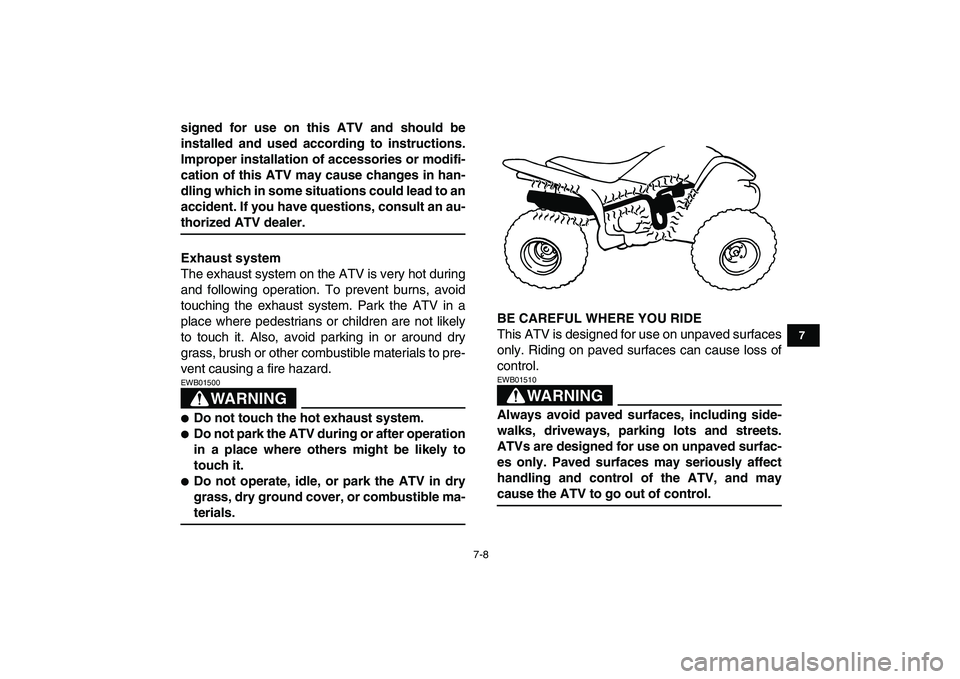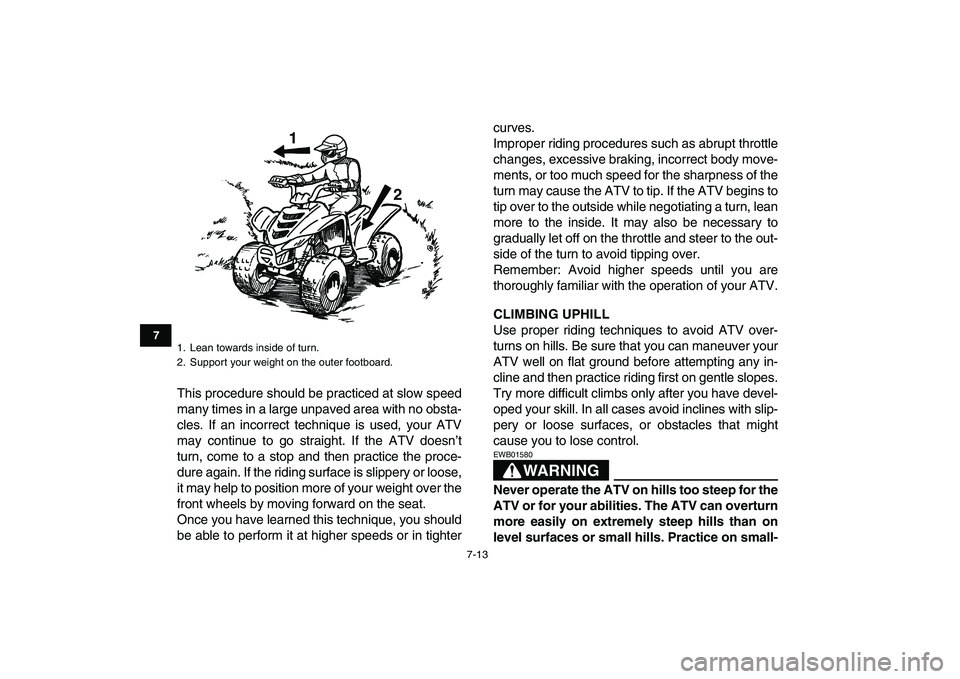Page 55 of 116

7-6
1
2
3
4
5
67
8
9
10
11
Yamaha recommends that all beginning riders
start off with the speed limiter turned in to limit the
amount of speed available while they learn. The
limiter may be gradually adjusted to increase max-
imum speed as the beginner becomes more famil-
iar with operating the ATV.
Loading and accessories
Use extra caution when riding the ATV with addi-
tional loads, such as accessories or cargo. The
ATV’s handling may be adversely affected. Re-
duce your speed when adding additional loads.
WARNING
EWB01460
�
Never exceed the stated load capacity for
this ATV.
�
Cargo should be properly distributed and se-
curely attached.
�
Reduce speed when carrying cargo or pull-
ing a trailer. Allow greater distance for brak-
ing.
�
Always follow the instructions in your Own-
er’s Manual for carrying cargo or pulling a
trailer.
During operation
Always keep your feet on the footboards during op-
eration, otherwise they may contact the rear
wheels.
1. Adjusting screw
1
MAXIMUM LOADING LIMIT
ATV loading limit (total weight of cargo, rider,
accessories, and tongue):
40.0 kg (88 lb)
Page 56 of 116
7-7
1
2
3
4
5
67
8
9
10
11
WARNING
EWB01470
Always keep both hands on the handlebars
and both feet on the footboards of your ATV
during operation. Removing even one hand or
foot can reduce your ability to control the ATV
or could cause you to lose your balance and
fall off of the ATV. If you remove a foot from a
footboard, your foot or leg may come into con-
tact with the rear wheels, which could injure
you or cause an accident.
Avoid wheelies and jumping. You may lose controlof the ATV or overturn.WARNING
EWB01480
Never attempt stunts, such as wheelies or
jumps. Don’t try to show off.
ModificationsWARNING
EWB01490
Never modify this ATV through improper in-
stallation or use of accessories. All parts and
accessories added to this ATV should be gen-
uine Yamaha or equivalent components de-
Page 57 of 116

7-8
1
2
3
4
5
67
8
9
10
11
signed for use on this ATV and should be
installed and used according to instructions.
Improper installation of accessories or modifi-
cation of this ATV may cause changes in han-
dling which in some situations could lead to an
accident. If you have questions, consult an au-
thorized ATV dealer.
Exhaust system
The exhaust system on the ATV is very hot during
and following operation. To prevent burns, avoid
touching the exhaust system. Park the ATV in a
place where pedestrians or children are not likely
to touch it. Also, avoid parking in or around dry
grass, brush or other combustible materials to pre-
vent causing a fire hazard.
WARNING
EWB01500
�
Do not touch the hot exhaust system.
�
Do not park the ATV during or after operation
in a place where others might be likely to
touch it.
�
Do not operate, idle, or park the ATV in dry
grass, dry ground cover, or combustible ma-
terials.BE CAREFUL WHERE YOU RIDE
This ATV is designed for use on unpaved surfaces
only. Riding on paved surfaces can cause loss of
control.WARNING
EWB01510
Always avoid paved surfaces, including side-
walks, driveways, parking lots and streets.
ATVs are designed for use on unpaved surfac-
es only. Paved surfaces may seriously affect
handling and control of the ATV, and may
cause the ATV to go out of control.
Page 58 of 116
7-9
1
2
3
4
5
67
8
9
10
11
While riding on unpaved public streets or roads
may be legal in your area, such operation can in-
crease the risk of collision with other vehicles.
Watch carefully for other vehicles. Make sure you
know your country’s laws and regulations before
you ride on unpaved public streets or roads. Do not
ride on any paved public street, road or motorway.
WARNING
EWB01520
Never operate this ATV on any paved street,paved road or motorway. You can collide with
another vehicle. In many areas, it is illegal to
operate ATVs on public streets, roads and
highways.
Know the terrain where you ride. Ride cautiously in
unfamiliar areas. Stay alert for
holes, rocks, or
roots
in the terrain, and
other hidden hazards
which may cause the ATV to upset.WARNING
EWB01530
Go slowly and be extra careful when operating
on unfamiliar terrain. Always be alert to chang-
Page 59 of 116
7-10
1
2
3
4
5
67
8
9
10
11
ing terrain conditions when operating the ATV.
WARNING
EWB01540
Do not operate on excessively rough, slippery
or loose terrain until you have learned and
practiced the skills necessary to control the
ATV on such terrain. Failure to use extra care
when operating on excessively rough, slippery
or loose terrain could cause loss of traction or
ATV control, which could result in an accident,
including an overturn.
When riding in an area where you might not easily
be seen, such as desert terrain, mount a caution
flag on the ATV. DO NOT use the flag pole bracket
as a trailer hitch.
Page 60 of 116

7-11
1
2
3
4
5
67
8
9
10
11
WARNING
EWB01550
Always mount a caution flag on the ATV to
make you more visible when operating in areas
where you might not be seen by other vehicles.
Watch carefully for other vehicles.
Do not ride in areas posted “no trespassing”.
Do not ride on private property without getting per-
mission.Select a large, flat, unpaved area to become famil-
iar with your ATV. Make sure that this area is free
of obstacles and other riders. You should practice
control of the throttle, brakes, and turning tech-
niques in this area before trying more difficult ter-
rain. Always avoid riding on paved surfaces: the
ATV is designed for use on unpaved surfaces only,
and handling maneuvers are more difficult to per-
form on pavement.
Set the parking brake and follow the instruction on
page 6-1 to start the engine. Once it has warmed
up you are ready to begin riding your ATV. Re-
member that the engine and exhaust pipe will be
hot when riding and afterwards; do not allow skin
or clothing to come in contact with these compo-
nents.
Page 61 of 116

7-12
1
2
3
4
5
67
8
9
10
11
With the engine idling, shift the transmission into
the drive position and then release the parking
brake. Apply the throttle slowly and smoothly. The
centrifugal clutch will engage and you will start to
accelerate. If the throttle is applied too abruptly, the
front wheels may lift off the ground, resulting in a
loss of directional control. Avoid higher speeds un-
til you are thoroughly familiar with the operation of
your ATV.
When slowing down or stopping, release the throt-
tle and apply the brakes smoothly and evenly. Im-
proper use of the brakes can cause the tires to lose
traction, reducing control and increasing the possi-
bility of an accident.
TURNING YOUR ATV
To achieve maximum traction on unpaved surfac-
es, the two rear wheels are mounted solidly on one
axle and turn together at the same speed. There-
fore, unless the wheel on the inside of the turn is al-
lowed to slip or lose some traction, the ATV will
resist turning. A special turning technique must be
used to allow the ATV to make turns quickly and
easily. It is essential that this skill be learned first at
low speed.
WARNING
EWB01570
Always follow proper procedures for turning
as described in this Owner’s Manual. Practice
turning at low speeds before attempting to turn
at faster speeds. Do not turn at speeds too fast
for your skills or the conditions.
As you approach a curve, slow down and begin to
turn the handlebars in the desired direction. As you
do so, put your weight on the footboard to the out-
side of the turn (opposite your desired direction)
and lean your upper body into the turn. Use the
throttle to maintain an even speed through the
turn. This maneuver will let the wheel on the inside
of the turn slip slightly, allowing the ATV to make
the turn properly.
Page 62 of 116

7-13
1
2
3
4
5
67
8
9
10
11
This procedure should be practiced at slow speed
many times in a large unpaved area with no obsta-
cles. If an incorrect technique is used, your ATV
may continue to go straight. If the ATV doesn’t
turn, come to a stop and then practice the proce-
dure again. If the riding surface is slippery or loose,
it may help to position more of your weight over the
front wheels by moving forward on the seat.
Once you have learned this technique, you should
be able to perform it at higher speeds or in tightercurves.
Improper riding procedures such as abrupt throttle
changes, excessive braking, incorrect body move-
ments, or too much speed for the sharpness of the
turn may cause the ATV to tip. If the ATV begins to
tip over to the outside while negotiating a turn, lean
more to the inside. It may also be necessary to
gradually let off on the throttle and steer to the out-
side of the turn to avoid tipping over.
Remember: Avoid higher speeds until you are
thoroughly familiar with the operation of your ATV.
CLIMBING UPHILL
Use proper riding techniques to avoid ATV over-
turns on hills. Be sure that you can maneuver your
ATV well on flat ground before attempting any in-
cline and then practice riding first on gentle slopes.
Try more difficult climbs only after you have devel-
oped your skill. In all cases avoid inclines with slip-
pery or loose surfaces, or obstacles that might
cause you to lose control.
WARNING
EWB01580
Never operate the ATV on hills too steep for the
ATV or for your abilities. The ATV can overturn
more easily on extremely steep hills than on
level surfaces or small hills. Practice on small-
1. Lean towards inside of turn.
2. Support your weight on the outer footboard.
1
2